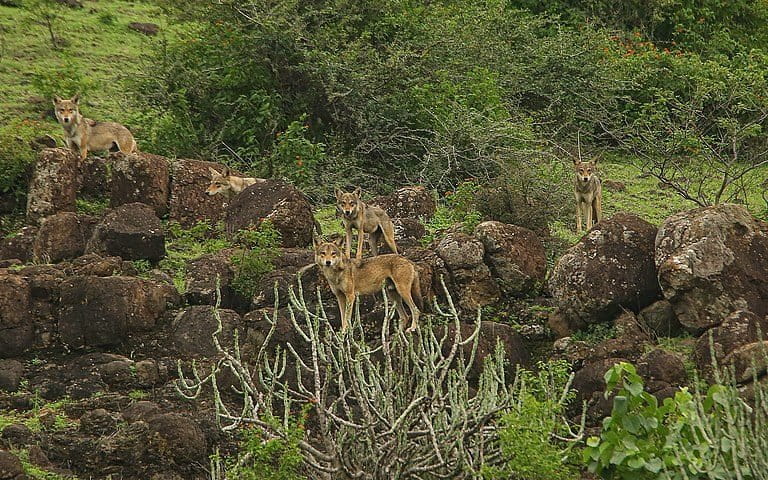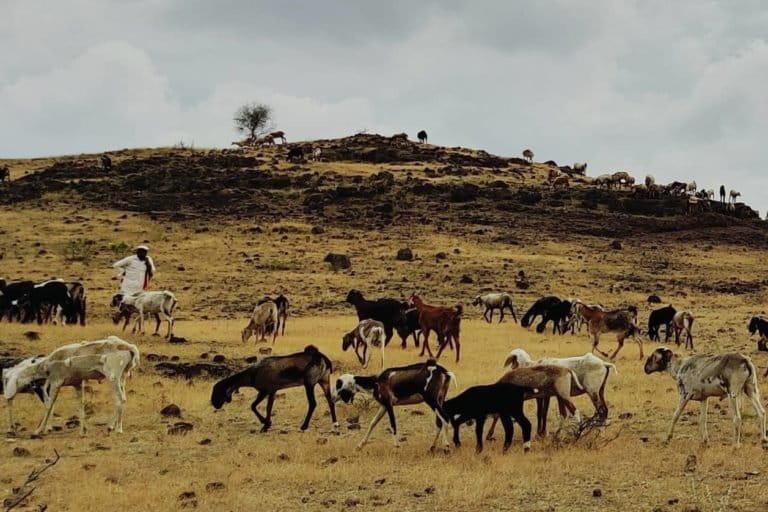- India’s unique wolf population and the grasslands on which they live are under increasing pressure due to compensatory plantations and development schemes.
- Counting the wolves could aid conservation efforts, but their elusiveness and highly mobile nature has posed a challenge to conducting a census.
- Identifying individual wolves by their howls is being studied as a potential technique for counting wolf population.
- While howl identification needs improvement, the pressing ecological challenges being faced by the unique biodiversity of India’s grasslands makes documenting them an urgent task.
“Some have a broken leg, some a broken tail.” That’s how Mihir Godbole says he identifies wolves in Saswad, just 31 kms away from the bustling city of Pune. A filmmaker and conservationist, he is founder of the The Grassland Trust and has been working with wolves in the outskirts of Pune for over a decade. In this time he has deeply studied the wolves and says he can identify 62 individuals by their unique characteristics.
As for identifying the rest of the unknown number of wolves roaming the grasslands it can, according to Sougata Sadhukhan, be “very tricky to do so by their coats alone.” Wolves can also be identified by their howls, according to Sadhukhan, who is a PhD student at the Wildlife Institute of India (WII) and co-authored a study last year on the potential of identifying Indian wolves by their howls as a non-invasive survey method.
When Godbole first began looking for wolves, it was hard to spot them. They would turn up at seemingly random spots. This made it hard to document and study them. Pastoral communities in the area have long since learned how to maintain a peaceful if tenuous relationship with these wolves. Looking to them for pointers, Godbole began documenting the biodiversity of the grasslands, especially the wolves.
But these grasslands, according to ecologist Abi Vanak, who has mapped India’s open natural ecosystems, are “the most undervalued ecosystems in India”. They are also under increasing pressure “due to the mad rush to plant trees in every available surface of land as a form of compensation for deforestation elsewhere”. He says this encourages, “species that require more cover, such as leopards, to colonise new areas, and potentially outcompete and displace the native species such as wolves.”
And it’s not just leopards, stray dogs pose an even greater threat to Indian wolves. Because they are so closely related, they can transmit diseases and mate with each other. This “can wipe out entire packs”, Vanak says, leading to grave “long-term consequences for the unique Indian wolf.” All these intersecting threats make it crucial to document the threatened population of India’s wolves.

The Indian grey wolf (Canis lupus pallipes) is protected under India’s Wildlife Protection Act (1972) but commonly found outside protected areas. Scientists are working on ways to identify individuals in the population, with acoustic-based monitoring being one such emerging technique. If successful, the scientists could conduct a census of India’s grey wolf population, making a case for its conservation and better understanding the species’ movement and behaviour.
Recognising the howls
Sadhukhan began studying the wolves with a slightly different goal. He would look for den sites and scat. “The main objective,” he said, “was to track how wolves disperse in human dominated landscapes.” As part of this project, Sadhukhan also collected recordings of wolves. It was when he presented these recordings at a WII seminar back in 2016 that he realised these could be used to identify individuals. “But at that time the data was not very good,” he said. So he turned to people on the ground with knowledge about the locations of wolves. With help from The Grassland Trust and forest guards, he set about studying wolf sounds in Maharashtra.
Among the many other sounds wolves make such as social squeaking, whining, whimpering, growling, the howl is the most suitable for identification. Wolves themselves use this as a marker, Sadhukhan explained, “They use howls to defend their territories and to locate individuals.”
Vanak’s interests, meanwhile, is the movement of carnivores in grasslands. He says, “Howl or call-back surveys are a widely used non-invasive sampling tool, and can be quite useful to understand the number of packs in an area. Often you can tell how many animals are calling as well, although it does not tell you anything about the total pack size (since some members may not participate in the call or they may not be distinguishable).”
But this becomes complicated when individuals move away from a pack or disperse, which Godbole mentioned happens every year.

Sadhukhan’s goal of identifying individuals through their howls could be useful not just for identifying these individuals, but also to track how they disperse. Howls can be heard at a fairly long distance making it easy to record them for further analysis. “Whenever we play another wolf’s call, the wolf whose territory it is, will respond,” he said. Having recorded howls from known individuals he trained a model on these recordings. “This is supervised clustering,” he explained, “Our perception is used to train the model. Based on the data, our model was 98% accurate.” This means if another howl was recorded from a known individual, the model did a pretty good job of identifying which wolf the howl came from. But could it identify an unknown individual? To see whether the model could successfully distinguish howls of a wolf it had never seen before, they fed it howls from a different set of wolves. This time, “we didn’t tell the model which howl was from which individual. This was 75% accurate.” Sadhukhan said. So the model would correctly identify 3 out 4 new wolves it encountered. That’s not good enough for population estimates, but it may be better than existing alternatives.
In human dominated landscapes, camera traps can be stolen, but perhaps the more pressing problem is the wolf’s natural tendency to avoid human things. Even if some wolves got accidentally photographed, it can be “very tricky to identify them with their coat patterns,” Sadhukhan explained. Capturing and tagging individuals is also much harder than recording howls from a distance.
Besides, the howl identification model can be improved massively by collecting more data. While Sadhukhan did not have this during his research, he says, “With improving technologies it can be very easy to collect more data. Acoustic tags on collared wolves can record 24×7.” With more data, he says it is possible to have an estimate of the wolf population within 5-10 years.
Read more: Environmental films that turn the lens on wildlife beyond national parks
Conserving grasslands and wolves
Meanwhile, just as Vanak warned, the plantations are inviting encroachers.
“Leopards and wild boars have been sighted, which have more conflict with humans,” Godbole said. The Grassland Trust is working with the Maharashtra state forest department to help the local communities deal with these encroachers. They are also working to “build local response teams who will deal with trivial incidents to actual emergencies” information about which can be “collected and sent to the government department for further processing.”

Grasslands challenge traditional conservation approaches not only because of the predominance of human activity, but also because of their resilience to anthropogenic disturbance. In fact, Vanak says, “grazing and fire play an important role in maintaining grassy biomes, and the colonial forestry approach to limiting grazing and burning will actually be deleterious to grassland conservation.”
Ongoing research continues to reveal the unique biodiversity and dynamic ecology of India’s neglected but resilient grasslands. Non-invasive methods of counting and tracking its apex predator could help make the case for the conservation of these ancient wolves and their habitat.
CITATION:
Sadhukhan, S., Root-Gutteridge, H. & Habib, B. Identifying unknown Indian wolves by their distinctive howls: its potential as a non-invasive survey method. Sci Rep 11, 7309 (2021). https://doi.org/10.1038/s41598-021-86718-w
Sadhukhan, S., Hennelly, L., & Habib, B. (2019). Characterising the harmonic vocal repertoire of the Indian wolf (Canis lupus pallipes). PloS one, 14(10), e0216186. https://doi.org/10.1371/journal.pone.0216186
Hennelly, L., Habib, B., Root-Gutteridge, H., Palacios, V., & Passilongo, D. (2017). Howl variation across Himalayan, North African, Indian, and Holarctic wolf clades: tracing divergence in the world’s oldest wolf lineages using acoustics. Current Zoology, 63(3), 341–348. https://doi.org/10.1093/cz/zox001
Banner image: A pack of wolves photographed in Nandurbar, Maharashtra in October 2021. Photo by The Grasslands Trust.
